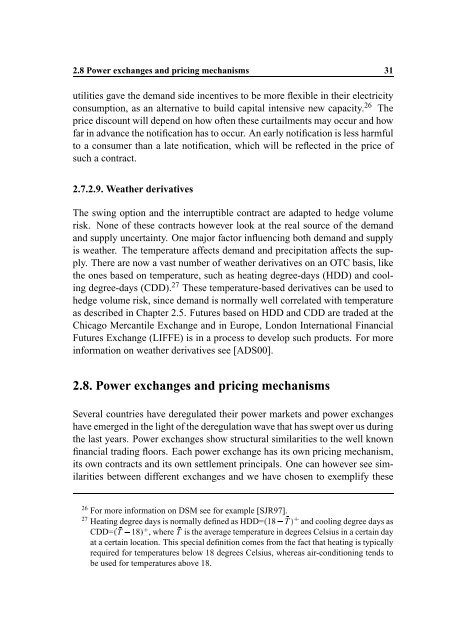Hedging Strategy and Electricity Contract Engineering - IFOR
Hedging Strategy and Electricity Contract Engineering - IFOR
Hedging Strategy and Electricity Contract Engineering - IFOR
Create successful ePaper yourself
Turn your PDF publications into a flip-book with our unique Google optimized e-Paper software.
2.8 Power exchanges <strong>and</strong> pricing mechanisms 31<br />
utilities gave the dem<strong>and</strong> side incentives to be more flexible in their electricity<br />
consumption, as an alternative to build capital intensive new capacity. 26 The<br />
price discount will depend on how often these curtailments may occur <strong>and</strong> how<br />
far in advance the notification has to occur. An early notification is less harmful<br />
to a consumer than a late notification, which will be reflected in the price of<br />
such a contract.<br />
2.7.2.9. Weather derivatives<br />
The swing option <strong>and</strong> the interruptible contract are adapted to hedge volume<br />
risk. None of these contracts however look at the real source of the dem<strong>and</strong><br />
<strong>and</strong> supply uncertainty. One major factor influencing both dem<strong>and</strong> <strong>and</strong> supply<br />
is weather. The temperature affects dem<strong>and</strong> <strong>and</strong> precipitation affects the supply.<br />
There are now a vast number of weather derivatives on an OTC basis, like<br />
the ones based on temperature, such as heating degree-days (HDD) <strong>and</strong> cooling<br />
degree-days (CDD). 27 These temperature-based derivatives can be used to<br />
hedge volume risk, since dem<strong>and</strong> is normally well correlated with temperature<br />
as described in Chapter 2.5. Futures based on HDD <strong>and</strong> CDD are traded at the<br />
Chicago Mercantile Exchange <strong>and</strong> in Europe, London International Financial<br />
Futures Exchange (LIFFE) is in a process to develop such products. For more<br />
information on weather derivatives see [ADS00].<br />
2.8. Power exchanges <strong>and</strong> pricing mechanisms<br />
Several countries have deregulated their power markets <strong>and</strong> power exchanges<br />
have emerged in the light of the deregulation wave that has swept over us during<br />
the last years. Power exchanges show structural similarities to the well known<br />
financial trading floors. Each power exchange has its own pricing mechanism,<br />
its own contracts <strong>and</strong> its own settlement principals. One can however see similarities<br />
between different exchanges <strong>and</strong> we have chosen to exemplify these<br />
26 For more information on DSM see for example [SJR97].<br />
27 Heating degree days is normally defined as HDD=7 18 8:9T;=< <strong>and</strong> cooling degree days as<br />
CDD=7>9T 8 18;=< , where 9T is the average temperature in degrees Celsius in a certain day<br />
at a certain location. This special definition comes from the fact that heating is typically<br />
required for temperatures below 18 degrees Celsius, whereas air-conditioning tends to<br />
be used for temperatures above 18.
















